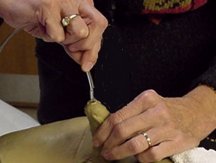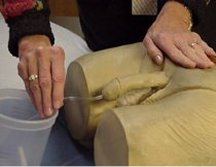Introduction to Male Intermittent Catheterization
One method of emptying the bladder is by doing what is called an intermittent catheterization (IC). An IC is also known as an "in and out" catheterization. This means that the catheter is inserted and left in only long enough to empty the bladder and then is removed. ICs are usually done every 4 or 6 hours, depending on the person's emptying needs. This lesson will talk about how to do an IC on a male.
IC: Step-by-Step Process (Clean Technique)
1. Gather the supplies.
- Catheter -Lubricating jelly -Soapy washcloth and wet washcloth -Moist towelettes that state “antibacterial” (only if soapy and wet washcloths are not available)
- Clean paper towel -IC bag or container for urine to drain
2. Wash hands with soap and water.
3. Prepare all needed supplies.
Catheter, lubricating jelly, IC bag or container, soapy and wet cloths or wipes, clean paper towel.
4. Wash the penis.
Wash with the soapy cloth and rinse with the wet cloth. Remember to pull the foreskin back (if present) and wash the head of the penis well.
5. Open the catheter.
If you are reusing your current catheter, take it out of your storage bag.
6. Connect the IC bag to the catheter or place the container in near reach.
7. Lubricate the catheter.
Squeeze the jelly onto the tip of the catheter, but do not let the jelly tube actually touch the catheter.
8. Wash your hands again with soap and water
9. Pick up Catheter.
Pick up the catheter about 2-3 inches from the tip. Make sure the other end of the catheter is either attached to the drainage bag or in the container.
10. Hold the penis.
Hold the penis straight up with the other hand and insert the catheter slowly until urine starts to drain. Then push the catheter in about one more inch.
11. Let the penis lie down naturally.
The bladder will empty better by letting the penis lie down naturally while holding the catheter in place.
12. When the urine stops flowing, gently press on the bladder area.
13. Withdraw the catheter slowly. 
This helps to completely empty the bladder.
14. Wash the penis.
When the catheter is out, wash the penis with a soapy cloth and rinse with a wet cloth. Dry well. Remember to pull the foreskin (if present) down over the head of the penis.
15. Empty the container or leg bag.
Rinse it out and clean with bleach water (the bleach/water concentration should equal 1 tablespoon of bleach to 1/2 cup of water).
16. Clean the catheter.
Clean the catheter with antimicrobial soap and water. Rinse with clean water, air dry and store the clean catheter in an envelope or paper bag (not a plastic bag). When putting it in the envelope, place it “tip first” so the next time you use it, the connection port comes out first and is ready to be attached to the leg bag.
17. Reuse catheter for up to 7 days.
Replace with a new catheter after 7 days.
18. Clean leg bag (if used).
Urinary drainage bags should be cleaned after each use. It is important to clean the bags properly to prevent germs from causing infections.
Cleaning leg bag:
- Mix 1 tablespoon of bleach and 1/2 cup of water in a cup.
- Mix solution and then pour it into a squeeze container/bottle.
- Empty all of the urine from the bag.
- Rinse bag with water for 10 seconds.
- Empty water into the toilet.
- Pour/squeeze about 2 tablespoons of the premixed bleach solution into the bag.
- Squeeze bag and allow bleach to get on all sides of the bag.
- Swish solution around inside the bag for at least 30 seconds.
- Discard solution into the toilet.
- Place bag on a clean paper towel.
- Leave any clamps on the bag open until the next time the bag is used.
The bags (Foley bags and leg bags) should be changed at least every month, but more often if needed.
19. Wash hands.
Common Questions
1. "What do I do when I can't get the catheter in?"
Ask the person to take a deep breath. While they are exhaling, try to re-insert the catheter. If that doesn't work, gently pull penis up toward the belly and try to re-insert. If that doesn't work, wait 10 minutes and try again. If still no success, call the nurse or doctor.
2. "What do I do if I drop the catheter on the floor?"
If you drop the catheter, you can wash it with soap and water and reuse it. It is important that germs do not enter the bladder during this procedure. If you prefer, you can get a clean catheter and start over
3. "What if I have spasms and can't get the catheter in?"
Wait for the spasm to pass before pushing the catheter any further.


